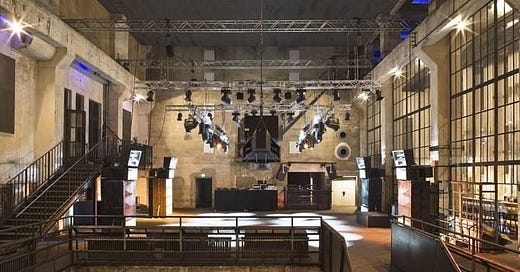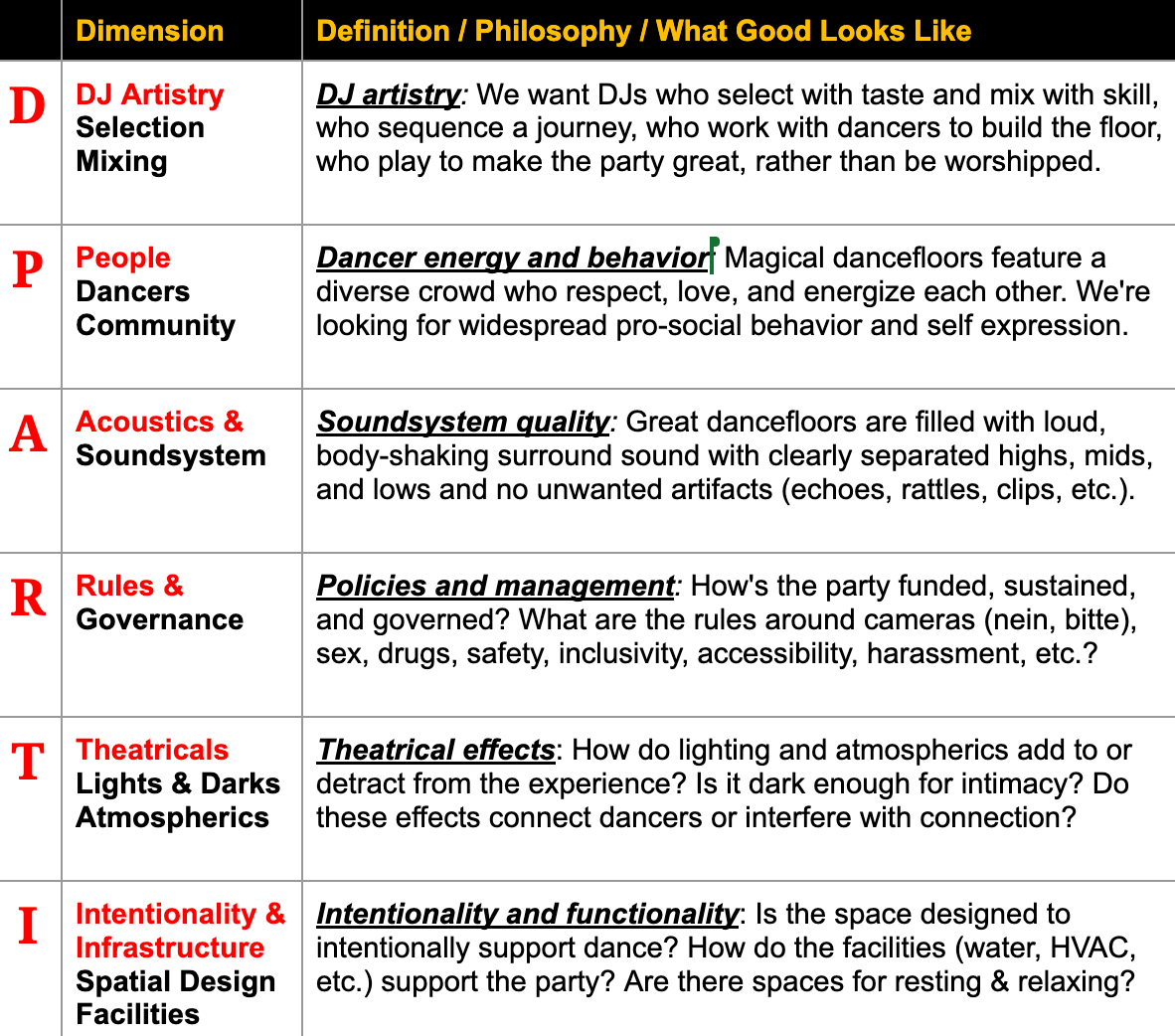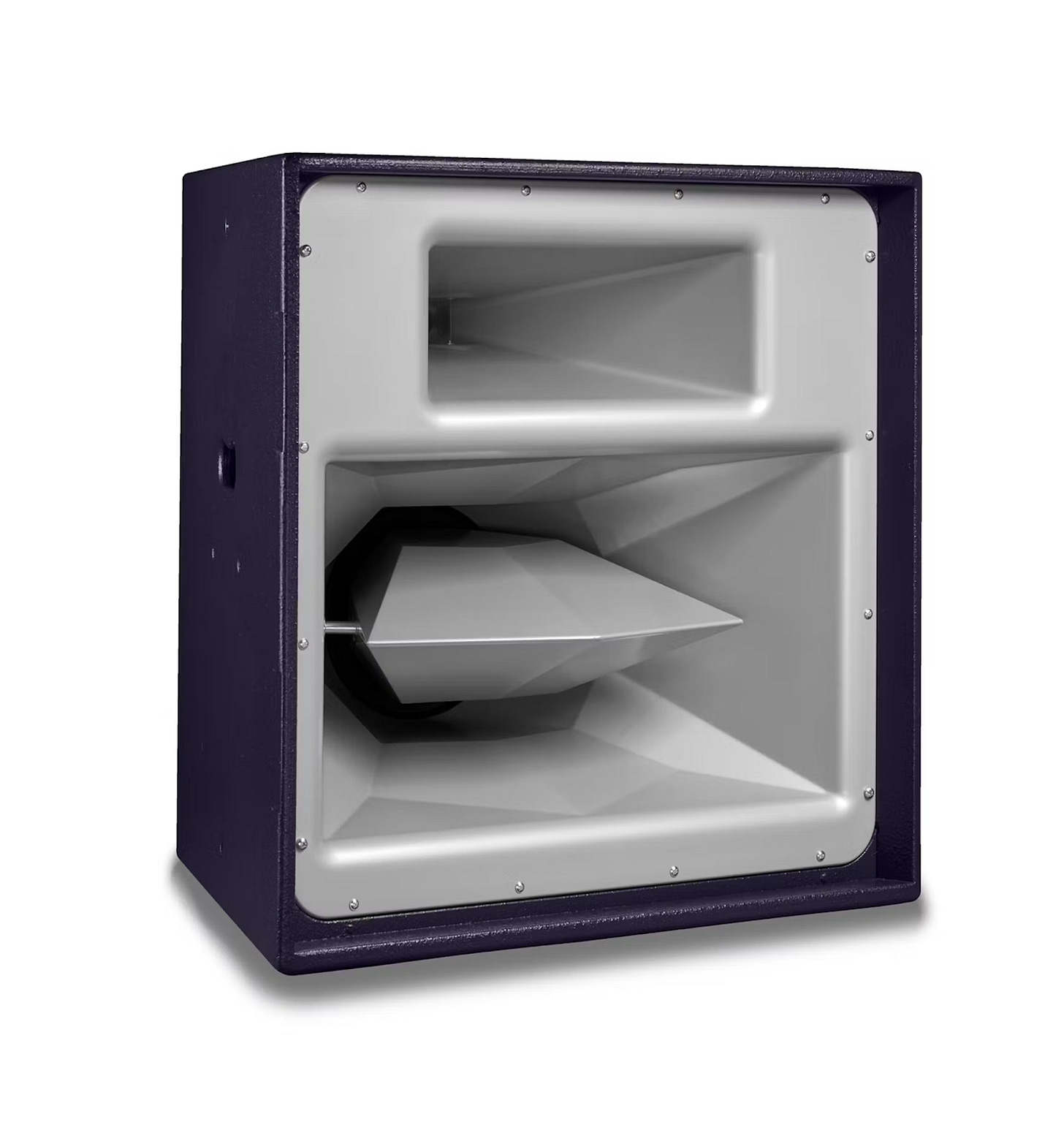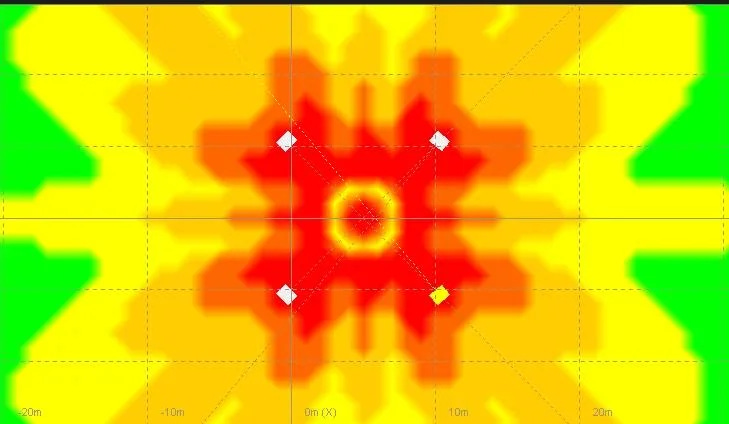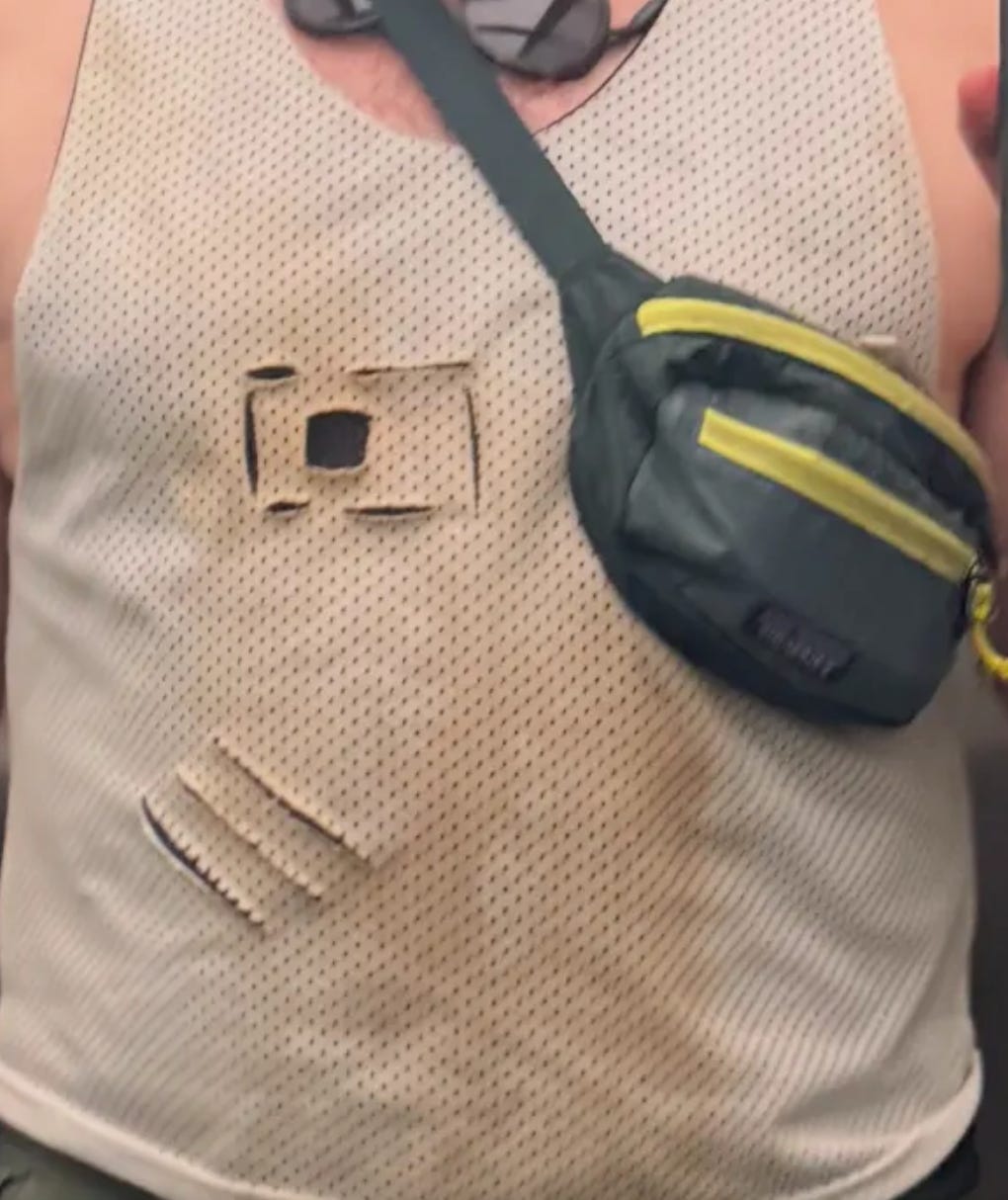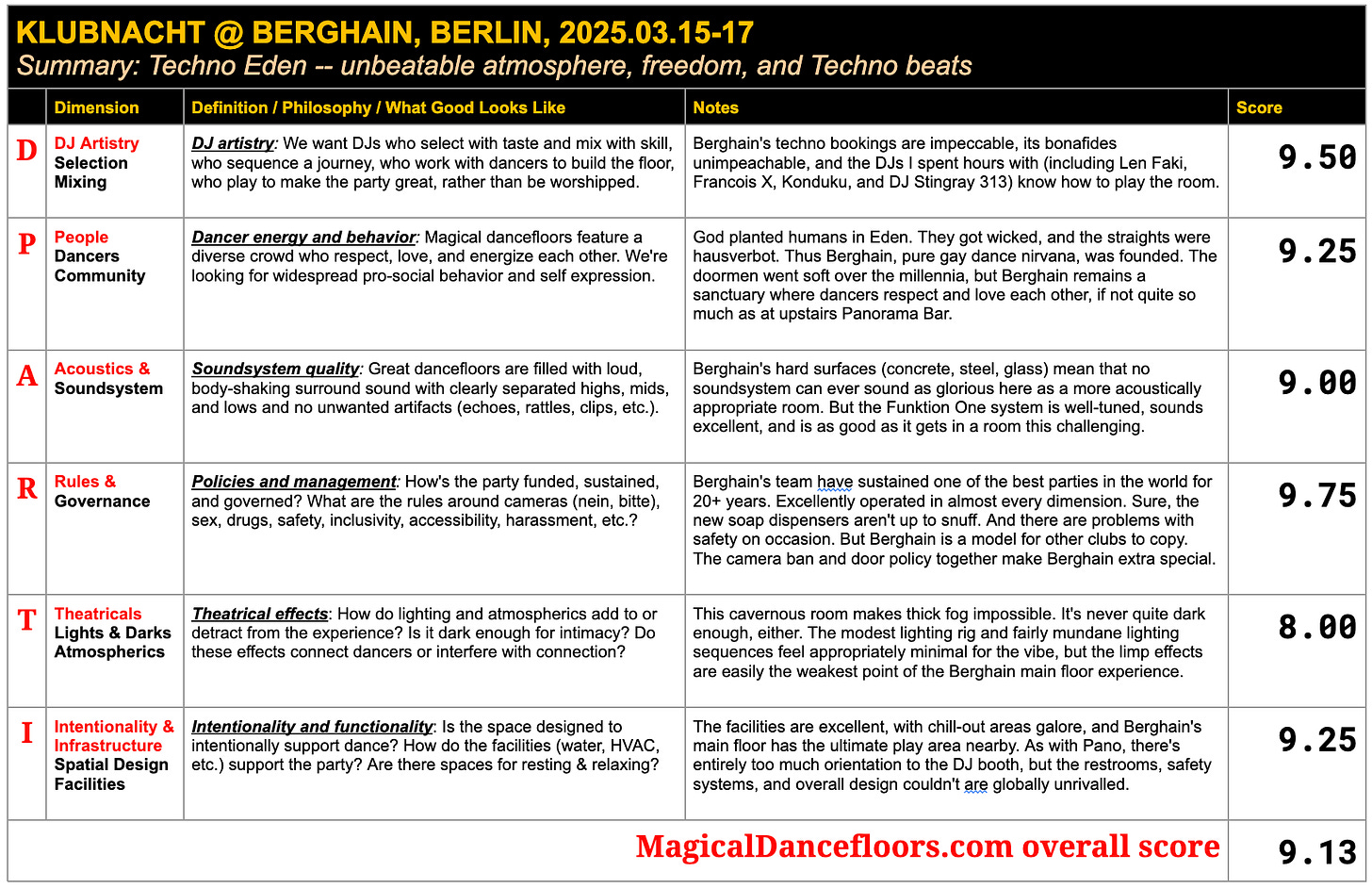A Love Letter to Berghain (Part 5/8): the Main Floor
Orthodox mass in the world's techno mecca
(This is part five of an eight-part series that begins with this article.)
This article, like my Panorama Bar review, focuses entirely on one of Berghain's dancefloors, this time the main floor. Of the 30 hours I spent inside Berghain over the span of my one glorious weekend in mid-March, about a quarter to a third of my time was spent on this dancefloor -- the cavernous space pictured here:
I dipped into and out of this space frequently, experiencing at least part of the sets of Konduku, Vlada, 69db, DJ Stringray 313, Interstellar Funk, Francois X and Len Faki, but most of my dancing was done while Len Faki captained the decks.
IīīīīI WHY I'M DOING THIS
I'll be using my standard scorecard to rate the success of Berghain's main dancefloor. Here's the scale I use to structure my thinking:
By using a consistent rating scale, I hope to bring some rigor to the discussion of the parties that feature magical dancefloors at their center. It's common to hear folks rave about "the best night of my life" (and I don’t doubt them) but I find these hyperbolic party reviews lacking in specifics, so I'm using the scorecard approach to articulate concrete reasons why a given dance party might end up being the best night of your life.
To this end, I write about truly magical places like Berghain, Stereo Montreal, Pikes Ibiza, Despacio, and so on. My research will take me to NYC and Black Rock City later this year. To be fair in my coverage, I also feel an obligation to write about more mainstream, less magical experiences because this is where the majority of the world encounters dance music. These venues -- the major music festivals, the Ibiza superclubs, and the corner pub -- are important benchmarks for me to discuss because putting them on the same scale and discussing them in comparison to the truly magical places helps make the differences between magical dancefloors and muggle dancefloors more clear.
Why is it important to me to draw these distinctions? Ultimately, my mission with all of this is to steer the dancing public to spend their time and money on the places that most deserve support: to sweaty, fun, life changing, and transformative dancefloors. At the same time, I hope to provide a guide for the industry folks (the promoters, artists, sponsors, and venue managers) that will help them improve the quality of the dance parties they throw.
Dancefloor magic isn't the exclusive domain of institutions like Berghain. This isn't a zero-sum game, where one place gains magic only if another place loses magic. I believe that every dancefloor has the potential for magic, if we study the successes, think deeply about them, and build their lessons into the dancefloors closer to home.
IīīīīI THE BERGHAIN SOUNDSYSTEM
Let's start our examination of the Berghain floor with an evaluation of the soundsystem. I start here because it’s often one of the first things people praise when they talk about Berghain.
The system that I experienced was installed late summer 2022, with some updates to the configuration since that date. The components are:
16 count: Funktion-One Evo 6EL -- "Evo 6EL supplements Evo 6E cabinets to provide additional mid bass headroom – especially useful for flown Evo 6E installations."
10 count: Evo 6EH -- "Evo 6EH is the mid-high section of an Evo 6. Most frequently used as the high power mid-high section of a modular system."
6 count: Funktion-One F124: "F124 features two voice coils to control the 24-inch cone. The F124 delivers excellent transient response and extended depth to below 30Hz."
12 count: Funktion-One F218 MkII: "The F218 MkII is the latest iteration of Funktion-One’s long dual 18” bass enclosure. [Delivers] tight, punchy, well defined clean bass from a relatively small package."
All of these speakers are arranged as four stacks pointing to the center of the dancefloor, each of which consists of, from the floor up:
3x F218 (totalling six 18" subs)
2x Evo 6EL
2x Evo 6EH
2x Evo 6EL
Within each of the four stacks, the Evos are stacked on top of the subs in two mirror stacks that point slightly away from each other in a pigeon-toe configuration to increase sound coverage over the floor.
Then there are two DS210 + DS15 pairs, one hung near the front of the room, one hung near the back of the room. These are carryovers from a prior configuration of the system. When the lights hit them just right, they look like masked demon faces floating above the dancefloor.
According to a gentleman who runs the biggest Funktion-One rental business in one European country, the Berghain system would have cost approximately €152K in 2021, though there were likely discounts offered because Berghain’s fame would be beneficial for Funktion-One.
The big issue with systems that have speaker stacks all facing inwards (and this includes my favorite systems at Despacio and Stereo Montreal) is that sound waves overlap in ways that can cause dead spots and unpleasant audio artifacts.
Redditor willrjmarshall wrote a wonderful analysis of the Berghain system here. To support his analysis, he shared the diagram above. In his words, "To illustrate, here’s a picture of the level at 60hz (medium-low bass) of a 4-point system. You can see crazy variations, with a big ring in the middle where the bass volume is dramatically quieter. The pattern is different at every frequency, but always similarly crazy!"
The analysis rings true for my experience of the Berghain system. There's a lot of variation throughout the Berghain floor. Depending on where you stand, the music can sound quite different. I personally love a system with bass notes so loud and clear that it feels like a donkey kick to my guts. I want it to feel like there are a couple of angry squirrels fighting in there, kicking their hind legs to the beat while gnawing angrily on anything that gets in the way of sacral chakra flow. Berghain's bass felt, for the most part, somewhat underpowered compared to what I've experienced at Stereo Montreal and at Despacio. It just lacked low-end sound pressure, or oomph.
But what Berghain lacks in bass, it makes up for in clarity of mids and highs. The system doesn't cause fatigue. It's not hard on the body or head anywhere on the floor, and there were several moments where I removed my ear protection to listen to a song with my naked ears, but only for a minute or two because at these levels, only stupid people rawdog a soundsystem.
In short, Berghain's soundsystem sounds great, but doesn’t sound as excellent as the systems found at other clubs. To be fair, many clubs don't have to deal with the same quantity of hard concrete and glass surfaces. Berghain was built for power generation, not for dancefloor acoustics, so some compromise should be expected. It's said that how a room sounds is largely due to the architecture and materials used -- and the world is littered with clubs that have Funktion-One systems that just don't sound great because the rooms they're placed in will never sound good. That the main room at Berghain can be made to sound this good, even with all of the obstructions and reflective surfaces, testifies to the love and care the management team have invested into this room.
IīīīīI BERGHAIN’S LIGHTING
To be blunt, the Berghain main room lighting rig feels out of date. It's not that I'm looking for a festival-style show. I find lasers and video screens cheesy, and think they're part of what's wrong with modern dance music because they fascinate dancers, grabbing them by the chin and turning their faces all in the direction of a "show" on a stage. These light shows destroy dancefloor cohesion, atomizing communities into audiences of individuals who might as well be watching a movie screen, for all they interact with each other. I intensely dislike lighting that forces an entire dancefloor to face one direction, because, at that point, we’re in concert territory.
For this reason, I appreciate the minimalist nature of the Berghain lighting rig. Approximately 12 moving heads pierce the darkness in fairly typical patterns. Sometimes the lights sweep fast with mechanical precision that matches the beat, sometimes they sweep slow with an organic acceleration and deceleration that feels connected to the melodic elements. The lighting is vibey and well-matched to the music.
The lighting guy has his pre-built DMX sequences, and he brings them in on phrase and as he feels the music changing. He dances with lights and makes very few mistakes (a mistake being, for example, a change-up in the lighting mid-phrase or the wrong pattern for a given musical moment).
And yet the lighting frequently underwhelms. One of the clearest problems is the fact that the room simply can't be kept full of atmospheric fog. When the lighting guy hits a button and summons a wave of fog, it fills the room within 10 or 20 seconds, but the fog disperses as quickly as it arrives. The massive cubic volume of the space and a solid HVAC system make atmospheric effects hard to sustain. As a result, there's little sense of mystery. There were never moments where I felt as if I didn't have a clear view of everyone around me. And when I ascend the balcony above the floor, I'm frequently able to survey the whole floor -- there's a general lack of privacy on the dancefloor. It’s never blanketed with theatrical fog.
Without thick fog or total darkness, I never feel lost, disoriented, or turned around. I always know which way the room's true north lies, I never lose sight of the exits, and I never accidentally collide with people in the way that I might on a floor where the atmospherics are thicker, the darkness more complete, and the lights less gentle. You might think those are good things, but I want to feel lost, turned around, torn apart, and overwhelmed. I generally feel far more in control of myself and my surroundings on the Berghain floor than I felt on the Panorama floor, where anarchy and chaos seem more present.
The contrast to Freddy's room, at Pikes Ibiza, couldn't be more stark. At Freddy's, fog sticks around for minutes at a time and is so thick that people cope by sliding along the walls to make their way through the room. When the fog is thick, letting go of the wall results in getting completely lost. There's no anchor point, no north star, no tether to reality. Similarly, Despacio's darkness is so complete, and the DJ booth so hidden, that dancers quickly orient towards the darkly sparkling disco ball at the center of the room as their anchor, resulting in instant community as the room forgets trying to look at the DJ and coalesces into a circle-shaped community.
Berghain's lowest lighting never sinks low enough for long enough for anyone to lose sight of the room's north. The room never disappears, the landmarks remain visibile throughout the night. Dancers here face the DJ most of the time -- standing shoulder to shoulder while staring ahead at the back of the person in front of them and dancing alone, for the most part. It's not just the lights -- part of the reason for this orientation is that the techno music played here feels fundamentally more introverted than the house music played on the floor above. Techno's minor chords intensify a dark and somewhat dangerous vibe — think streets of London with Jack the Ripper on the prowl — whereas house music's major chords and more vocal-driven tracks tend to make inspire positive feelings about interacting with my fellow humans.
In short, the Berghain dancefloor is at its weakest in the area of theatricals. It's not terrible, but it's not in my personal top five dancefloors, from a lighting perspective. Thankfully the stunning backdrop of the architecture goes a long way towards filling the gap left by the lackluster lighting.

It's fine to understand the specs of a lighting system or soundsystem, but how does it make us feel when a specific DJ is sending their hand-selected tracks into the system for amplification and broadcast?
Now's the time for me to get out of my head and into my body. Here are some memories of my time on the Berghain floor.
IīīīīI ON THE FLOOR
I'm standing on the balcony above the main floor, dancing while looking out over the pulsing crowd. I lean over to the sound guy to try to strike up a conversation about the system. The language barrier makes it hard for us to understand each other, but when I ask him about whether he has to do anything to the soundsystem to tune it for each DJ, he simply says to me, "it's Len Faki." I think I understand his meaning: nothing needs to be touched, because Len Faki knows this room well, having played it more than 92 times to date.
Earlier on Klubnacht, I'm standing under the above-mentioned balcony, just outside the entrance to the darkroom area. I feel drawn to this area for some reason -- perhaps because it feels hidden and less beholden to the north-facing vibe in the rest of the room. While dancing here at the gateway to the darkroom, a couple of completely naked men move into my field of view. One grabs hold of the steel I-beam pillar that holds up the stairs to Panorama bar and sticks his ass out for the other to fuck. They're both beautiful men, fit, naked, and energetic, and their love making moves through the stages from fucking to ass-eating to blowjobs and finally to a full underarm tongue bath. I've never had anyone’s tongue bathe my armpits and feel a pang of envy. I add a new to-do item to my fantasy bucket list.
I'm not great at "reading" a scene like this, but it reminds me of the online exhortations of some Berghain veterans that men should be fucking out in the open at every opportunity to help take back the club from the creeping and corrosive heteronormativity that more lax door policies have enabled. These men want to be seen and have deliberately chosen this location in the open for their tryst instead of the dark room a few steps away.
Even if the men weren't politically asserting their rights to fuck in the open -- even if it were a case of the dark room being so full that the sex spilled out onto the dancefloor -- I love that Berghain is so sex positive that folks don't feel the need to wait for the fog to roll in or for the lights to go dim. Fucking is always an option.
At the peak of my LSD trip, I find myself craving a hug and simultaneously feeling grateful for my girlfriend, whose generous offer of childcare allows me to be present on this weekend. She’s given me the gift of Berghain, and I’m overwhelmed with gratitude. She's back in California, but I’m suddenly urgent with a need to thank her. So, aided by chemically-enhanced magical thinking, I open my third eye and search for a solution. Immediately, I identify a steel i-beam that had been in my field of vision for at least an hour.
I step up to the beam and rest my hand on it. This is the same beam that I saw one man brace himself against with both hands while bent at the waist for his lover's urgent ministrations. I allow myself to explore the subtle texture of rust lacquered over with sweat, grime, oil, and cigarette smoke. It's filthy, but it's an honest bit of functional architecture, warm and solid.
I feel the vibration of the music in this beam. I feel the vibration of people in the beam when the footstep energy of those headed to Panorama Bar flows through the metal balcony into the beam I’m holding. I feel the way the beam is anchored into the concrete at my feet, and I sense the dirt far below these layers of steel and concrete, earth from which I came and to which I’ll return.
I give the beam a shove. It doesn't move at all. I hammer on it with the bottom of my fist. It doesn't notice me. Sound and footsteps can vibrate it, but nothing I can do to it has any effect. Well, if it won’t yield to me, I can yield to it. I step up to it, my toes touching it at its base, and I give it a full body hug.
It should be noted here that I have hugged many, many trees. If you've never hugged a tree, please make it a point next time you’re outside to give it a go. There's something beautiful about hugging another living thing and feeling the life and truth of that thing -- the bark, the hardness, the subtle movement (if there's wind), the susurration of the leaves. I'm told I give good hugs, and am no stranger to hugging things that aren't typically meant to be hugged.
This is how I hug this pillar of Berghain: I wrap my arms around it, I think thoughts of gratitude to it for being here for me, for being strong, for being a surrogate for my girlfriend whom I can't hug at this moment. I press my lips to the pillar, then press my nose and forehead to the pillar. I hug it harder, wrapping my legs around it like a fireman descending a pole, like a lover saying goodbye at the airport, like a sea-sick passenger on a ship deck trying to stay upright. This beam is my strength, my support, my lover, my anchor, my calmness.
I stay locked to this pillar for I don't know how long. My hug loosens and turns into a dance. I'm an exotic dancer, grinding against the pillar. I push against it, thrust against it, hip check it, and bounce my body against it to the relentless beat, and I feel truly as if I'm dancing with my partner. I of course recognize that I'm on some good LSD, but this understanding doesn't diminish the joy that this metal proxy for my lover back home gives me.
(Later, in the elevator back at my hotel, after I inhaled with terrible manners three large plates of breakfast at the buffet line, I catch my first look of myself in a mirror since the day before. I'm confused for a minute to see a stain on my shirt, but then I remember the rusty pillar and the comfort it gave me.)
I'm still hugging and dancing with the pillar -- eyes closed, just pushing against the beam and enjoying hugging it, when someone's fingers -- all 10 of them -- suddenly tickle the nape of my neck. It's the sort of move you do when you're trying to scare a friend whom you've crept up on in the dark. I had been deep in reverie with the beam, floating in my own world, and someone had entered my dream through an interdimensional portal in order to snatch me back into the here and now.
I wheel around to find the culprit and see a Japanese woman wearing a neon tracksuit in parachute nylon. She's wearing a pixie cut and she's tiny, maybe 100 pounds, and bouncing with a b-boy lightness and swagger right behind me. She gives me a smile and bounces away, like a butterfly looking for another flower to alight on. My reverie breaks, and I'm back in the real world, or at least in the Berghain world.
I encounter this woman many hours later in Pano and make a point of thanking her for coming along when she did. "Thank you! You pulled me back into the real world," I say. Her face breaks into a big smile and she says, "you looked very happy." That's it. We dance for a while near each other, then drift apart. I marvel at how she's able to bounce without breaking a sweat at all.
Downstairs, I'm still dancing near the beam, shortly after the Japanese woman snatched me out of my dream, when I encounter a man I'll call "Jann" here. He's over seven feet tall and thin like a marathon runner. I'm overflowing with good feelings so I just say hi, and introduce him to my pillar. I explain that I've named the pillar after my girlfriend.
"And where is your girlfriend tonight?" Jann asks, a bit of sly grin adding punctuation to the question. He's flirting.
"Back in California, taking care of my children," I reply.
"And she trusts you alone here?" he asks, gesturing to the darkroom behind us.
"Yes... I promised her I'd behave."
"And have you behaved?" he asks.
"Yes, of course!"
"Good boyfriend," he says, patting me on the shoulder, somewhat patronisingly. I feel like I've failed some kind of test. Before we part ways, I test whether he remembers the name I've given the pillar, and he does. At least he’d been listening attentively.
Not long after the conversation with Jann, a beautiful third-gender person dancing nearby catches my attention. They're shirtless, with long, intricate braids of black-brown hair and dark skin. They could be Filipino or American Indian or Hawaiian with their hybrid looks. Their high cheekbones and grey-green eyes mesmerize me. I instantly feel that they might be the sort of person who is forever 30 -- one of Berghain's resident vampires, never aging, always appearing out of the clouds of fog at just the right moment to rescue or devour the lost.
I don't know how it happens, but one moment I'm dancing on my own, then I'm dancing with them, and then they're beckoning me to follow them into the middle of the Berghain dancefloor. I don't ask why, or where we're going. It feels natural to follow them, so I do. I take a last look at the beam and enter the center of the Berghain floor.
We chat a little while dancing to Len Faki and I learn their name is Zand (not their actual name, but I mishear their name and will keep the mistake here, for their privacy). They live in Berlin and attend Berghain regularly. They tell me I looked like I needed to be here, in this spot in the middle of the dancefloor.
I dance there for an hour, or two hours, or three. I don't know how long. I lose myself in the music and when I look up, Zand is gone. I never see them again. It doesn't matter -- the whole point of our meeting was to move me to the center of the room where I fall into synch with the people around me, dancing the way they dance -- a sort of Germanic techno swing that isn't my usual style, but that feels right for the tunes that Faki is playing. I copy their moves to see whether this style of dance feels right for the music. It does feel right: effortless but effusive, arms and legs and core all moving like a machine to the beat. I feel like I never want to move from this spot. I’m invincible.
Dancing here on the main floor, I feel less connected to everyone else than I felt on the Pano dancefloor. It might be that I haven't danced here long enough to put down roots and build a little community with my fan action, but I feel that it's also the strong orientation toward the DJ booth that almost everyone in the room obeys. There's an order or an orthodoxy at work. This feels like a more religious space in every sense of the word: the cathedral-height ceiling, the introspective demeanor of most folks here, the cool stillness of this dancefloor compared to the steamy chaos of the Pano dancefloor, the distance of the DJ in their pulpit, the walls between the dancefloor and the bars on either side of it. Berghain is yin to Pano's yang in many ways.
Later, I spend several hours dancing on a podium in the back of the room. The wooden boxes built from plywood flex under my feet and the give feels glorious after the experience of dancing on concrete. The podium boxes give me the freedom to flail my arms about in big movements and to use my fan as a flow toy. I'm up there for hours and enjoy the way the podium gives me my own space where I don't have to worry about whether I'm going to whack someone with my arms or my fan. It's the perfect little antisocial bubble to get lost in, sealed off from social interaction by simple elevation.
I see a red light moving through the crowd below. As the light gets nearer my podium, I make out a bald, shirtless Asian man wearing a head-mounted red flashlight. He darts about the floor picking up empty bottles and he’s working hard, his skin slick with sweat as he bends down over and over to snatch bottles from corners and ledges where they've been tucked away. He drops the bottles into a plastic crate, stacks the full crate on his hand-truck, and continues his search. I hope this man or one of his colleagues found the cash that fell out of my pocket on my first night here. He and his colleagues remind me of the mechanically-minded Morlocks of H.G. Wells’ The Time Machine who scurry about to keep the machines running and demand in return only a small sacrifice of flesh now and then from the fatted calf Eloi.
On the Berghain main floor, I encounter far more latex-clad dancers. It's cooler here and folks are less likely to swing a lit cigarette into their expensive rubber wear. Perhaps they're avoiding the heat of the Panorama floor. These folks look like superheros in their tight, bright costumes, but they're some of the least expressive dancers. The latex does more of the self-expression work; the human inside seems to be just trying to stay cool enough not to drown in their own sweat.

IīīīīI A HORNY PARADOX
On almost every dancefloor on the planet, dancing together makes people hot for each other. Sometimes platonically, sometimes sexually. The egregious displays of health and vitality make it easy to imagine someone's stamina in other realms, the gyration of a dancer's hips to the rhythm communicate how well they might apply friction at the point where two bodies meet. Some moves (e.g., the twerk) involve a dancer making their ass clap in a way that visually recalls the ripple that flows when one body collides with another from behind. I could go on for pages about this, but we don't need pages, we just need George Bernard Shaw:
“Dancing is a perpendicular expression of a horizontal desire.”
Strange, therefore, that Berghain’s main floor paradoxically felt like one of the least horny dancefloors I've ever been on. How could a dancefloor that features so much nudity, so much fetish wear, so many faces flushed with the afterglow of recent orgasm, so much proximity to sex that -- if not for the ever-present cigarette smoke that masks Berghain's animal smells -- our nostrils would involuntarily flare with the aromas of sweat, musk, and cum?
I believe the answer is simple. If two (or three or more) people want to have sex with each other, there are rooms just a few steps off the dancefloor where they can consummate their desire. There's no need for an escalating flirtation of touches and surreptitious grinding on the dancefloor. Berghain’s dancers needn't wait for darkness before they slip their hands down someone else’s pants. All they need to do is tug a hand, or gesture with their head, and a few steps later the vertical dancers can translate their rhythmic movement to more horizontal planes.
As a result, people on the Berghain floor are often sexually spent. Tensions don't build over the course of a night before dancers can take each other home. Tensions instead build over the course of an hour. Or a song. The people here dance with post-nut clarity.
Due to this dynamic, Berghain's dancefloor feels more purely dedicated to dance than dancefloors that aren't attached to adult play spaces. On other dancefloors, people get handsy. At Berghain, people simply step off to get off quickly and anonymously in the darkroom. Of course the nearness of sex makes it one of the sexiest places on earth to dance, but once you're in the building, the delineation of space makes for greater clarity on the dancefloor. There’s a narrowing of purpose from the heterogeneity found on most dancefloors to the shared, single purpose of the Berghain floor. This homogeneity of purpose adds to the sacred feeling of the space.
IīīīīI SOME LEN FAKI IDS (IF SHAZAM IS TO BE BELIEVED)
Black Circles by Mike Dearborn
Playground by Game Boy
Sanctuary by Dejure
Pump Up Da Bass by Da Tekno Warriors
Rock by Kari Shearman
Cafe Del Mar (Three 'n One Remix) by Energy 52
La Musika Tremanda (Yves Deruyter Remix) by Ramirez
After Life (FSOE762) by Ehren Stowers
Crazy Tech by Techint Electornico
Crazy Summer by Tura
Border Line by The Strings ITA
Disonancia 2 by Berend Salverda
On the Run by Gerd Elysis Raudenbusch
Altitude Compensation by Aly & Fila
Ph1 by Circulation
Why (The Cloudy Day Remix) by Denis Sender
Magic O by Terrace
Eyes Behind the Door by Steve Murphy
Serendipity (Max Mix) by Mario Piu
Out of the Blue y System F
Justice by Gareth Wynn
Work that Body (Intrique Hardclub Mix) by Temper
Walk with Me by DJ Eclipse
Blue Coast (Red Eye Mix) by Several Spirits
Constellation by Dok & Martin & Matteo Vitanza
Giesl Ejector by Kozi Komatsu
Magnitude by Johan Gielen
Lo-Fi (Lo-Fi Original Mix) by Phunk Investigation
Break Away by DVS1
Adagio for Strings by Tiesto
Tiempo (Mondragon Remix) by Lucius Young
Traffic by Tiesto
Rhythm 11 by Deadwalkman
Life's Little Pleasures (Continual Trix Mix) by Trix
Everything Is Energy by Metta & Glyde
Dances on Wood by Thomas Schumacher
I See Her Eyes (Rework 2018) by Aleksey Litunov
Bla Bla Bla by Gigi D'Agostino
Let the Beat Go On (Long) by Dr. Alban
Goa Head by Carlim Sakoo
Track 02 by Nortek
Return of the Predecessor by Fractal Strangers
Waterfall by Atlantic Ocean
Blow up the Speakers (Vocal Radio Edit) by The M.O.O.N. & DJ Ghost
Engage by Benfay
Go Back by Albanez
Operation Blade by Public Domain
Ham (Hardspace Mix) by Aoki Takamasa
The Man With the Red Face by Laurent Garnier
IīīīīI THE DPARTI SCORECARD - BERGHAIN MAIN FLOOR
In the end, I found myself preferring the pro-social chaos of Panorama Bar over the sacred religiosity of the Berghain floor, but Berghain's sound is clearly superior to Pano's sound, and the adjacent darkroom make this a dancefloor like no other on earth.


